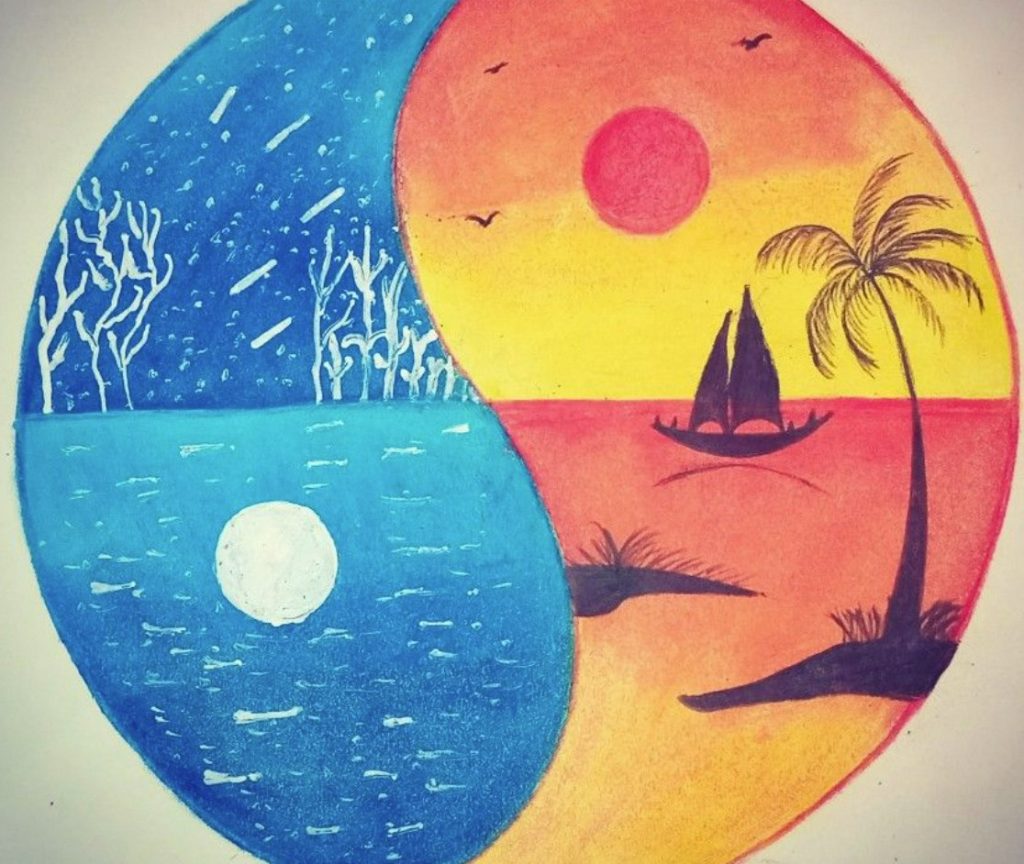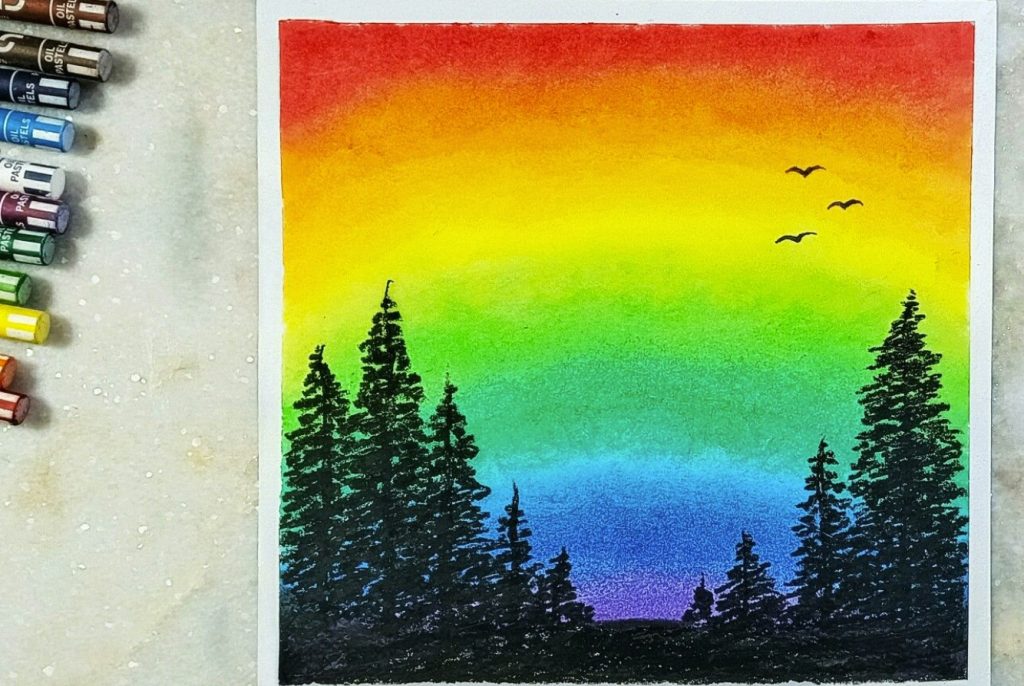Sunsets, with their fiery displays of color, hold a captivating allure. But the magic doesn’t end with the setting sun. Twilight, that ethereal time between day and night, offers an equally captivating spectacle, a symphony of soft hues and deepening shadows. This article explores the fascinating world of capturing twilight landscapes with oil pastels, guiding you through techniques to translate this fleeting beauty onto your canvas.

Part 1: Embracing the Canvas: Setting the Stage for Twilight
1. Surface Matters: Choosing the Right Canvas
Twilight landscapes rely heavily on subtle color variations and soft light. To best capture these nuances, choose a smooth, heavyweight paper specifically designed for oil pastels. This smooth surface allows for effortless blending and ensures your colors won’t snag or tear, allowing you to create delicate transitions between light and shadow. Consider the size of your artwork; a larger canvas allows for a more expansive interpretation of the twilight scene.
2. A Palette of Tranquility: Selecting Your Oil Pastels
When depicting twilight landscapes with oil pastels, it’s important to recognize that the color palette differs from the vibrant and fiery hues of sunsets. Instead, opt for oil pastels that encompass cooler tones such as blues, purples, and grays for the sky, gradually transitioning to darker greens and browns for the foreground elements to convey the fading light of dusk. Additionally, consider including a few subtle pops of orange, pink, or red to represent the last embers of the setting sun and infuse the scene with a touch of warmth. This varied palette is particularly crucial in capturing the nuanced and shifting light conditions of twilight. Therefore, when selecting your oil pastels, look for high-quality options. They should have excellent blending capabilities as these are essential for effectively capturing the subtle variations of twilight light.

Part 2: Building the Foundation: Composition and Establishing the Mood
1. Leading Lines: Guiding the Viewer’s Eye
One effective technique for enhancing twilight landscapes is to incorporate leading lines that draw the viewer into the scene. This provides a sense of depth and visual interest. Introducing elements such as a winding path through the foreground, a lone tree silhouetted against the sky, or the meandering line of a distant river can serve as powerful visual devices. These guide the viewer’s eye towards the heart of the artwork. These leading lines not only create a sense of depth but also invite the viewer to emotionally and visually engage with the tranquil beauty of the twilight scene. They can explore the artwork in a more immersive way. By strategically incorporating leading lines, you can effectively guide the viewer’s gaze and create a sense of narrative and exploration within the twilight landscape. This further enriches the overall impact and appeal of your artwork.
2. Evoking Emotion: Capturing the Essence of Twilight
Twilight evokes a sense of peace and tranquility. Consider using a limited color palette with muted tones to establish this mood. Experiment with soft, layered strokes to create a hazy atmosphere. Leave areas of the canvas unfilled to allow the negative space represent the inky blackness of the approaching night. By capturing this essence, you create an artwork that goes beyond just depicting the scene, but also conveys the emotions associated with twilight.

Part 3: A Dance of Light and Shadow: Capturing Twilight’s Nuances
1. Mastering Blending: Creating Seamless Color Transitions
The success of a twilight oil pastel landscape hinges on capturing the subtle interplay of light and shadow. Utilize blending tools like cotton swabs, blending stumps, and your fingers to create seamless transitions between colors. Focus on creating soft gradients, blurring the edges of light and shadow for a realistic effect. Experiment with varying pressure on your blending tools to achieve different degrees of softness, ensuring the light fades gently into the deepening shadows.
2. Layering for Depth: Building Dimension in Your Artwork
Establishing a convincing sense of depth is pivotal in drawing the viewer into your twilight scene. To achieve this, it is essential to begin with light base colors for both the sky and foreground in your artwork. As your work progresses, layer darker colors on top, particularly in areas that are furthest from the light source. This approach will effectively simulate the atmospheric perspective often observed during twilight. It contributes to the overall impression of depth and distance within your composition. When working with oil pastels, it’s important to utilize a light touch initially. Gradually build up color intensity to create a realistic and immersive effect. Furthermore, it’s essential to bear in mind that while you can always add more color, removing it can be quite challenging. Therefore, exercising patience and strategic layering are key to achieving the desired depth and realism in your twilight artwork.

Part 4: Capturing Details: The Finishing Touches in Twilight
1. Silhouettes and Texture: Adding Depth and Interest
Silhouetted elements like trees, mountains, or buildings in the foreground can add depth and a sense of mystery to your twilight scene. Use dark tones of oil pastels to create these shapes, ensuring they contrast with the subtle hues of the sky. For added interest, experiment with textured strokes to create a sense of roughness on tree bark or the uneven terrain of the foreground.
2. Starlight and Moonlight: Hints of Night’s Embrace
As twilight deepens, the first stars begin to twinkle and the moon emerges. Use tiny dots of white or light yellow oil pastel to represent the stars, leaving them slightly unblended to create a sense of distance. For the moon, utilize a pale yellow or white oil pastel, blurring the edges for a soft glow. These subtle details hint at the approaching night and complete the transformation of your vibrant sunset scene into a captivating twilight landscape.

By mastering these techniques and tapping into your creative spirit, you can capture the fleeting beauty of twilight in oil pastels. Experiment with different oil pastel brands and explore the magic of creating a symphony of soft hues and deepening shadows. Remember, the journey of artistic exploration is just as important as the final product. Embrace the tranquility of twilight as you translate its essence onto your canvas, and discover the unique voice you can express through the vibrant world of oil pastels.


